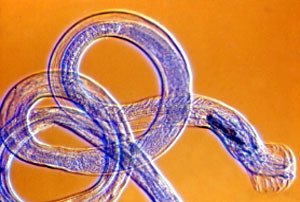The genetics & genomics of parasitism
Parasitism is a common lifestyle, especially among the nematodes. Nematodes have evolved from free-living ancestors into parasites at least five times in their evolutionary history, suggesting that there are common mechanisms by which nematodes can be parasites. In this strand of work we are trying to understand the molecular basis of parasitism in nematodes.
We use the natural nematode parasite of rats, Strongyloides ratti. Its life-cycle has an almost unique feature, namely the existence of an adult parasitic female form and a genetically identical adult free-living form. By comparing these two forms, both in the genes they express and in the proteins they possess, we can find the genes / gene products present in the parasitic form (but absent from the free-living form) which are, putatively, those that allow this species to be a successful parasite.
Also, by comparing the genomes of Strongyloides with closely related species that are semi-parasitic or free-living, we can discover the genes that are specifically associated with Strongyloides' parasitic lifestyle.
This work is being led by Vicky Hunt, and has been done in collaboration with Matt Berriman and colleagues at the Wellcome Trust Sanger Institute and Jonathan Wastling.
The immunology of wild mammals
Hosts and their immune responses are the environment in which parasites live, reproduce and evolve.
While a very great deal is known about the immune responses that laboratory animals make, the responses of wild animals are very poorly understood. The very different lives of wild animals - competing for food and mates, and being exposed to a range of infections - will have profound effects on their immune responses. While many factors can affect immune responses (sex, genetics, nutritional status, age, infection status etc.) the relative roles of these (and other) factors for wild animals' immune responses is unknown. For wild animals we therefore know what may affect their immune responses, but not what actually does.
To discover the immune state of wild mammals, we have assayed in-depth the immune responses of wild mice (Mus musculus domestics), the same species as the laboratory mouse. We find that wild mice have an immune system that is in a highly activated and antigen-primed state, a state very different from that of laboratory mice. Genetically the wild mice are in a highly structured population, with mice from even closely neighbouring sites being genetically separate.
We are now working to understand what extrinsic and intrinsic factors in the lives of these wild mice drive their immune responses. This study will therefore define what controls the immune responses of a wild animal, so that we can better understand the processes of infection and disease, and their dynamics, in wild mammal populations.
Phenotypic plasticity & developmental decisions
Many nematodes make developmental decisions in their life-cycle; Strongyloides spp. is a notable example. In this work we using the model nematode C. elegans to ask basic questions about the phenotypic plasticity of developmental choices of key life history traits.
Dauer larva formation in C. elegans is an example of phenotypic plasticity, i.e. where one genotype can produce different phenotypes. Comparing different C. elegans strains we have found that they differ in how their dauer larva phenotype changes, for the same change in the environment. This diversity of phenotypic plasticity is reminiscent of the developmental diversity of S. ratti.
For C. elegans dauer larva plasticity we are interested in understanding (i) why different phenoptypically plastic responses exist and (ii) their molecular and genetic basis. We are tackling this by seeing how suites of life-history traits differ between C. elegans strains as the environment changes, and by quantitative trait mapping and genomic-based approaches. The recent discovery of the molecular components of the C. elegans pheromone that induces dauer larva formation, has now also suggested a rich social biology component to this phenotypically plastic trait.
